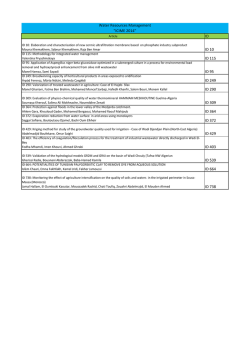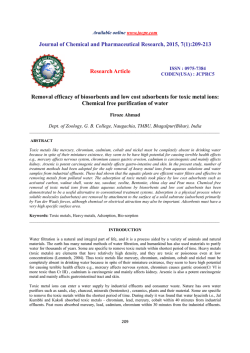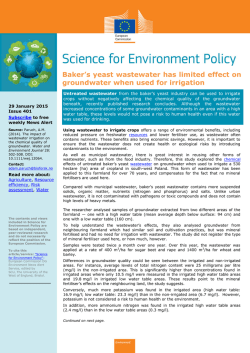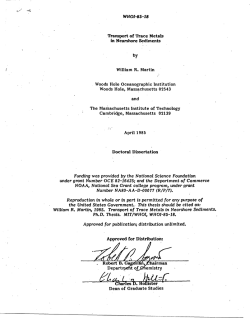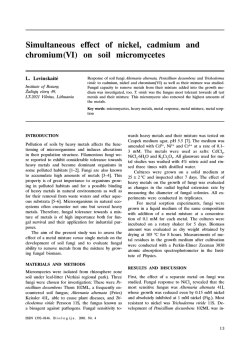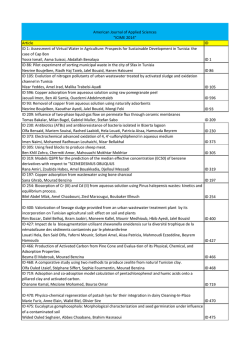
Heavy metal accumulation in vegetables irrigated
Food Chemistry 111 (2008) 811–815 Contents lists available at ScienceDirect Food Chemistry journal homepage: www.elsevier.com/locate/foodchem Heavy metal accumulation in vegetables irrigated with water from different sources Monu Arora a,*, Bala Kiran b, Shweta Rani a, Anchal Rani a, Barinder Kaur a, Neeraj Mittal a a b Department of Microbiology, Maharishi Dayanand College, Sri Ganganagar, Rajasthan 335 001, India Department of Environmental Science and Engineering, Guru Jambheshwar University of Science and Technology, Hisar (Haryana) 125 001, India a r t i c l e i n f o Article history: Received 9 January 2008 Received in revised form 20 February 2008 Accepted 22 April 2008 Keywords: Daily intake Heavy metal Plant uptake Wastewater irrigation a b s t r a c t The present study was carried out to assess levels of different heavy metals like iron, manganese, copper and zinc, in vegetables irrigated with water from different sources. The results indicated a substantial build-up of heavy metals in vegetables irrigated with wastewater. The range of various metals in wastewater-irrigated plants was 116–378, 12–69, 5.2–16.8 and 22–46 mg/kg for iron (Fe), manganese (Mn), copper (Cu) and zinc (Zn), respectively. The highest mean levels of Fe and Mn were detected in mint and spinach, whereas the levels of Cu and Zn were highest in carrot. The present study highlights that both adults and children consuming vegetables grown in wastewater-irrigated soils ingest significant amount of these metals. However, the values of these metals were below the recommended maximum tolerable levels proposed by the [Joint FAO/WHO Expert Committee on Food Additives (1999). Summary and conclusions. In 53rd Meeting, Rome, June 1–10, 1999]. However, the regular monitoring of levels of these metals from effluents and sewage, in vegetables and in other food materials is essential to prevent excessive build-up of these metals in the food chain. Ó 2008 Elsevier Ltd. All rights reserved. 1. Introduction Industrial or municipal wastewater is mostly used for the irrigation of crops, mainly in periurban ecosystem, due to its easy availability, disposal problems and scarcity of fresh water. Irrigation with wastewater is known to contribute significantly to the heavy metals content of soil. Heavy metals are very harmful because of their non-biodegradable nature, long biological half-lives and their potential to accumulate in different body parts. Most of the heavy metals are extremely toxic because of their solubility in water. Even low concentrations of heavy metals have damaging effects to man and animals because there is no good mechanism for their elimination from the body. Nowadays heavy metals are ubiquitous because of their excessive use in industrial applications. Wastewater contains substantial amounts of toxic heavy metals, which create problems (Chen, Wang, & Wang, 2005; Singh, Mohan, Sinha, & Dalwani, 2004). Excessive accumulation of heavy metals in agricultural soils through wastewater irrigation, may not only result in soil contamination, but also affect food quality and safety (Muchuweti et al., 2006). Food and water are the main sources of our essential metals; these are also the media through which we are exposed to various toxic metals. Heavy metals are easily accumulated in the edible parts of leafy vegetables, as compared to grain or fruit crops (Mapanda, Mangwayana, Nyamangara, & Giller, 2005). Vegetables take * Corresponding author. Tel./fax: +91 11 25572757. E-mail address: [email protected] (M. Arora). 0308-8146/$ - see front matter Ó 2008 Elsevier Ltd. All rights reserved. doi:10.1016/j.foodchem.2008.04.049 up heavy metals and accumulate them in their edible (Bahemuka & Mubofu, 1991) and inedible parts in quantities high enough to cause clinical problems both to animals and human beings consuming these metal-rich plants (Alam, Snow, & Tanaka, 2003). A number of serious health problems can develop as a result of excessive uptake of dietary heavy metals. Furthermore, the consumption of heavy metal-contaminated food can seriously deplete some essential nutrients in the body causing a decrease in immunological defences, intrauterine growth retardation, impaired psycho-social behaviour, disabilities associated with malnutrition and a high prevalence of upper gastrointestinal cancer. The present study was conducted with an aim to compare the heavy metals (copper, manganese, zinc and iron) accumulation potential of some of the commonly grown vegetables in Rajasthan, India. Irrigation of crops with wastewater is a very common practice in India. The effect of irrigation with wastewater is also studied in these crops to observe the concentration of accumulated metals to which human beings are exposed. Furthermore, the daily intake of these metals is calculated for both adults and children. 2. Materials and methods 2.1. Study area and sampling All the experiments were conducted at the environmental science laboratory of Maharishi Dayanand College, Sri Ganganagar, Rajasthan, India. Samples of some commonly grown vegetables, i.e., radish (Raphanus sativus), spinach (Spinacia oleracea), turnip 812 M. Arora et al. / Food Chemistry 111 (2008) 811–815 2.2.1. Digestion of the vegetable samples For each vegetable, three powdered samples from each source of irrigation (0.5 g each) were accurately weighed and placed in crucibles, three replicants for each sample. The ash was digested with perchloric acid and nitric acid (1:4) solution. The samples were left to cool and contents were filtered through Whatman filter paper No. 42. Each sample solution was made up to a final volume of 25 ml with distilled water and analyzed by atomic absorption spectrophotometry (932AA, GBC Scientific Equipment, Dandenong, Australia). (Brassica rapa), brinjal (Solanum melogena), cauliflower (Brassica oleracea var. botrytis), lotus stem (Nelumbium nelumbo), mint (mentha), coriander (Coriandrum sativum), methi (Trigonella foenum-graecum), and carrot (Daucus carota), were collected from three different sites in Sri Ganganagar district, namely the vegetable market (unknown source of irrigation), and agricultural fields irrigated with fresh water and wastewater. For metal analysis, only the edible parts of vegetable samples were used. 2.2. Sample preparation All the collected samples of various vegetables were washed with double distilled water to remove airborne pollutants. The edible parts of the vegetable samples were weighed and air-dried for a day, to reduce water content. All the samples were then oven-dried in a hot air oven at 70–80 oC for 24 h, to remove all moisture. Dried samples were powdered using a pestle and mortar and sieved through muslin cloth. a 450 Fresh water 2.3. Standards Standard solutions of heavy metals (1000 mg/l), namely copper (Cu), zinc (Zn), manganese (Mn) and iron (Fe) were procured from Merck. Solutions of varying concentrations were prepared for all the metals by diluting the standards. Wastewater Unknown source 400 Metal concentration (mg/kg) ** * 350 * 300 250 * * ** 200 * 150 100 50 0 b Radish Spinach 80 Turnip Brinjal Fresh water * Cauliflower Lotus stem Wastewater Mint Coriander Methi Carrot Methi Carrot Unknown source Metal concentration (mg/kg) 70 60 50 40 30 20 10 0 Radish Spinach Turnip Brinjal Cauliflower Lotus stem Mint Coriander Fig. 1. Heavy metal concentrations in the edible parts of vegetables grown with fresh water, wastewater and with an unknown source of irrigation for (a) Fe and (b) Mn. The error bars indicate the standard deviation while the asterisks indicate significant differences in heavy metal concentrations between plants grown in wastewater or from an unknown source, with respect to fresh water, at p < 0.05 (*) and p < 0.01 (**). 813 M. Arora et al. / Food Chemistry 111 (2008) 811–815 2.4. Data analysis All the data are presented in terms of means and standard error of triplicates. Observations on heavy metal concentrations in response to different irrigation sources were tested for significance of difference using the t-test. The daily intake of metals (DIM) was calculated by the following equation: DIM ¼ ½MXKXI ; W ð1Þ 3. Results and discussion where [M], K, I and W represent the heavy metal concentrations in plants (mg/kg), conversion factor, daily intake of vegetables and average body weight, respectively. The conversion factor used to convert fresh green vegetable weight to dry weight was 0.085, as described by Rattan, Datta, Chhonkar, Suribabu, & Singh, 2005. The average adult and child body weights were considered to be 55.9 and 32.7 kg, respectively, while average daily vegetable intakes for adults and children were considered to be 0.345 and 0.232 kg/ person/day, respectively, as reported in the literature (Ge, 1992; Wang, Sato, Xing, & Tao, 2005). a 3.1. Metal accumulation in plants The application of wastewater generally led to changes in the physicochemical characteristics of soil and consequently heavy metal uptake by vegetables. The heavy metals concentrations in edible parts of vegetables in Sri Ganganagar District, Rajasthan are shown in Figs. 1 and 2. It can be clearly observed that the concentration of all the heavy metals is higher in wastewater-irrigated vegetables than freshwater-irrigated plants. Table 1 shows a very high concentration of heavy metals in vegetables irrigated with 25 Fresh water Waste water Unknown source Metal concentration (mg/kg) 20 ** ** 15 * 10 * 5 0 Radish Spinach Turnip Brinjal Cauliflower Lotus stem Mint Coriander Methi Carrot b 60 Fresh water Waste water Unknown source Metal concentration (mg/kg) 50 * 40 * ** 30 * 20 10 0 Radish Spinach Turnip Brinjal Cauliflower Lotus stem Mint Coriander Methi Carrot Fig. 2. Heavy metal concentrations in the edible parts of vegetables grown with fresh water, wastewater and with an unknown source of irrigation for (a) Cu and (b) Zn. The error bars indicate the standard deviation while the asterisks indicate significant differences in heavy metal concentrations between plants grown in wastewater or from an unknown source, with respect to fresh water, at p < 0.05 (*) and p < 0.01 (**). 814 M. Arora et al. / Food Chemistry 111 (2008) 811–815 wastewater. Heavy metals concentration was in the order of Fe > Mn > Zn > Cu for all the plants except radish, turnip and carrot; for these the trend was Fe > Zn > Mn > Cu. The concentrations of iron were in the range of 79–340 mg/kg, 116–378 mg/kg and 82–360 mg/kg in vegetable samples irrigated with fresh water, waste water and those of unknown treatment, respectively (Fig. 1a). Mint leaves were found to accumulate the maximum concentration of iron, in the range of 340–378 mg/kg, but no significant effects were observed. Wastewater-irrigated lotus stem showed a significantly (p < 0.01) higher accumulation of iron than freshwater-irrigated. Spinach, turnip, brinjal and cauliflower showed significantly (p < 0.05, p < 0.01) higher accumulation of iron when irrigated with wastewater or when the water treatment was not Table 1 Heavy metal content (dry weight basis) in plants grown in wastewater-irrigated soils Plants Values Fe Zn Mn Cu Radish Range Mean ± S.E. Range Mean ± S.E. Range Mean ± S.E. Range Mean ± S.E. Range Mean ± S.E. Range Mean ± S.E. Range Mean ± S.E. Range Mean ± S.E. Range Mean ± S.E. Range Mean ± S.E. 111–122 117 ± 5.4 279–333 309 ± 27.0 176–212.4 197 ± 19 113–144 125 ± 16 198–232 215 ± 17.0 311–353 335 ± 22.0 335–412 378 ± 39.0 292–326 313 ± 18.0 275–322 302 ± 24.0 200–235 216 ± 18.0 21.1–24.3 22.5 ± 1.6 31.2–34.9 33.1 ± 1.9 28.8–30.3 29.3 ± 0.8 20.7–25.1 22.5 ± 2.3 38.2–41.8 40.2 ± 1.9 28.7–35.2 31.9 ± 3.2 41.4–47.4 45.0 ± 3.2 29.8–32.8 30.9 ± 1.6 23.5–32.4 27.1 ± 4.7 40.4–50.7 46.4 ± 5.3 10.0–17.0 12.8 ± 3.7 64.3–73.8 69.4 ± 4.8 11.8–23.3 18.2 ± 5.9 38.1–47.7 42.7 ± 4.8 33.5–47.5 41.3 ± 7.2 52.6–63.0 57.3 ± 5.3 61.0–70.8 67.0 ± 5.2 41.4–47.6 43.9 ± 3.2 31.5–47.5 38.0 ± 8.4 14.0–20.4 17.4 ± 3.2 5.21–6.42 5.96 ± 0.7 15.9–17.4 16.5 ± 0.8 12.4–20.1 16.1 ± 3.9 7.92–11.8 10.2 ± 2.0 4.8–5.5 5.23 ± 0.4 12.8–15.2 13.7 ± 1.3 11.8–14.1 12.7 ± 1.2 10.9–12.7 12.1 ± 1.0 15.4–22.5 18.2 ± 3.8 12.5–21.6 16.8 ± 4.6 Spinach Turnip Brinjal Cauliflower Lotus stem Mint Coriander Methi Carrot known. The concentrations of iron in most of the vegetables bought from the market were closer to those of vegetables irrigated with waste water than to samples irrigated with fresh water. This meant that the source of irrigation in market-bought samples was probably wastewater because of the scarcity of fresh water. A similar trend was observed for the other metals, i.e., maximum accumulation in wastewater-irrigated vegetables and minimum in freshwater-irrigated samples. The differences of the metal contents in these vegetables depend on the physical and chemical nature of the soil and absorption capacity of each metal by the plant, which is altered by various factors like environmental and human interference, and the nature of the plant (Zurera, Moreno, Salmeron, & Pozo, 1989). For Mn, vegetables showed a range of 7–45 mg/kg with fresh water irrigation, 12–69 mg/kg with wastewater irrigation and 11–50 mg/kg where the source of irrigation was unknown (Fig. 1b). The concentration of Zn was 14– 42 mg/kg, 22–46 mg/kg and 19–45 mg/kg in freshwater, wastewater and unknown source of irrigation, respectively (Fig. 2a). Copper concentration was 2.5–10.9 mg/kg, 5.2–16.8 mg/kg and 4.1– 15.9 mg/kg in freshwater, wastewater and unknown source of irrigation, respectively (Fig. 2b). Table 2 shows that maximum Mn accumulation was in spinach (45–69 mg/kg), whereas carrot contained the maximum concentration of Cu but not at a significantly higher level than the freshwater one. Spinach showed a highly significant (p < 0.01) increase in copper accumulation when treated with wastewater. The concentration of Zn was significantly (p < 0.05) higher in wastewater-irrigated radish, spinach, turnip and cauliflower. All vegetables had lower levels of zinc and copper than the maximum permissible value (60 mg/kg and 40 mg/kg) in food proposed by FAO/WHO (Codex Alimentarius Commission, 1984) but still significantly higher than the plants irrigated with fresh water. Our results show agreement with previous studies showing elevated levels of heavy metals in edible parts of food crops with continuous wastewater irrigation (Khan, Cao, Zheng, Huang, & Zhu, Table 2 Daily intake of metals (mg) for individual heavy metals in different vegetables grown in freshwater-rrigated soils Plants Radish Spinach Turnip Brinjal Cauliflower Lotus stem Mint Coriander Methi Carrot Zn Cu Fe Mn Adults Children Adults Children Adults Children Adults Children 0.008 0.009 0.009 0.009 0.013 0.012 0.021 0.011 0.01 0.022 0.009 0.0101 0.0108 0.01 0.0147 0.0139 0.0243 0.0129 0.0119 0.0258 0.0023 0.0025 0.0046 0.002 0.0013 0.0057 0.0044 0.0041 0.0037 0.0042 0.0026 0.0029 0.0052 0.0023 0.0015 0.0066 0.005 0.0047 0.0043 0.0048 0.059 0.119 0.059 0.042 0.05 0.143 0.179 0.144 0.155 0.095 0.068 0.137 0.068 0.048 0.057 0.165 0.206 0.166 0.178 0.11 0.0038 0.0237 0.0071 0.0037 0.0101 0.0218 0.0213 0.0169 0.0121 0.0076 0.0044 0.0273 0.0081 0.0043 0.0116 0.025 0.0245 0.0194 0.0139 0.0087 Table 3 Daily intake of metals (mg) for individual heavy metals in different vegetables grown in wastewater-irrigated soils Plants Radish Spinach Turnip Brinjal Cauliflower Lotus stem Mint Coriander Methi Carrot Zn Cu Fe Mn Adults Children Adults Children Adults Children Adults Children 0.012 0.017 0.015 0.012 0.021 0.017 0.024 0.016 0.014 0.024 0.014 0.02 0.018 0.014 0.024 0.019 0.027 0.019 0.016 0.028 0.0031 0.0087 0.0085 0.0053 0.0027 0.0072 0.0067 0.0063 0.0096 0.0088 0.0036 0.01 0.0097 0.0061 0.0032 0.0082 0.0077 0.0073 0.011 0.0101 0.0613 0.1621 0.1033 0.0657 0.1128 0.1757 0.1985 0.1644 0.1585 0.1133 0.07 0.186 0.119 0.076 0.13 0.202 0.228 0.189 0.182 0.13 0.0067 0.0364 0.0095 0.0224 0.0217 0.03 0.0352 0.023 0.02 0.0091 0.0077 0.0419 0.011 0.0257 0.0249 0.0345 0.0404 0.0265 0.0229 0.0105 815 M. Arora et al. / Food Chemistry 111 (2008) 811–815 Table 4 Daily intake of metals (mg) for individual heavy metals in different vegetables grown with irrigation water from an unknown source Plants Radish Spinach Turnip Brinjal Cauliflower Lotus stem Mint Coriander Methi Carrot Zn Cu Fe Mn Adults Children Adults Children Adults Children Adults Children 0.012 0.013 0.014 0.01 0.019 0.016 0.023 0.014 0.011 0.024 0.013 0.015 0.016 0.012 0.022 0.018 0.027 0.017 0.013 0.027 0.003 0.004 0.005 0.004 0.002 0.006 0.008 0.006 0.007 0.008 0.003 0.004 0.006 0.004 0.002 0.007 0.009 0.006 0.008 0.01 0.06 0.158 0.096 0.043 0.077 0.151 0.189 0.158 0.157 0.097 0.069 0.181 0.11 0.05 0.089 0.173 0.217 0.182 0.181 0.112 0.0063 0.0266 0.0082 0.0126 0.0135 0.024 0.0236 0.0198 0.0144 0.0083 0.0072 0.0306 0.0094 0.0144 0.0155 0.0276 0.0271 0.0228 0.0166 0.0096 2007); (Liu, Zhao, Ouyang, Soderlund, & Liu, 2005). Results from present and previous studies (Liu et al., 2005; Muchuweti et al., 2006; Sharma, Agrawal, & Marshall, 2007) demonstrate that the plants grown on wastewater-irrigated soils are generally contaminated with heavy metals, which pose a major health concern. toring of these toxic heavy metals from effluents and sewage, in vegetables and in other food materials is essential, to prevent their excessive build-up in the food chain. 3.2. Daily intake of metals (DIM) The authors would like to place on record their sincere thanks to Dr. R. S. Poonia and Dr. B. M. Kanwar for their valuable help. In order to observe the health risk of any pollutant, it is very important to estimate the level of exposure, by detecting the routes of exposure to the target organisms. There are several possible pathways of exposure to humans but amongst them the food chain is the most important pathway. The daily intake of metals was estimated according to the average vegetable consumption for both adults and children (Tables 2–4). The DIM values for heavy metals were high when based on the consumption of vegetables grown in wastewater-irrigated soils. The highest intakes of Fe, Zn, Mn, and Cu were from the consumption of mint, carrot, spinach and methi, respectively, for both adults and children, grown in wastewater-irrigated soils. The findings of this study regarding DIM suggest that the consumption of plants grown in wastewater contaminated soils is high, compared to the other two treatments but is nearly free of risks, as the dietary intake limits of Cu, Fe, Zn, and Mn in adults can range from 1.2 to 3.0 mg, 10.0 to 50.0 mg, 5.0 to 22.0 mg and 2.0 to 20.0 mg, respectively (World Health Organization., 1996). However, there are also some other sources of metal exposure, like dermal contact, dust inhalation, and ingestion of metal-contaminated soils, which were not taken into account in the present study. So further detailed studies are required to completely understand the problem and risk involved. 4. Conclusion Heavy metals show a significant build-up with continuous irrigation with wastewater and long-term irrigation of farmlands with wastewater has led to contamination of food crops in the study area. Wastewater-irrigated spinach has shown significantly (p < 0.05, p < 0.01) higher accumulation of iron, manganese, copper and zinc, compared to the freshwater-irrigated spinach, indicating the highest metal absorption for this vegetable. All the vegetables contained heavy metals were lower than the recommended tolerable levels proposed by Joint FAO/WHO Expert Committee on Food Additives. The authors strongly recommend that people living in this area should not eat large quantities of spinach, so as to avoid excess accumulation of heavy metals in the body. Dietary intake of food results in long-term low level body accumulation of heavy metals and the detrimental impact becomes apparent only after several years of exposure. Thus regular moni- Acknowledgements References Alam, M. G. M., Snow, E. T., & Tanaka, A. (2003). Arsenic and heavy metal contamination of vegetables grown in Santa village, Bangladesh. Science of the Total Environment, 308, 83–96. Bahemuka, T. E., & Mubofu, E. B. (1991). Heavy metals in edible green vegetables grown along the sites of the Sinza and Msimbazi rivers in Dar es Salaam, Tanzania. Food Chemistry, 66, 63–66. Chen, Y., Wang, C., & Wang, Z. (2005). Residues and source identification of persistent organic pollutants in farmland soils irrigated by effluents from biological treatment plants. Environment International, 31, 778–783. Codex Alimentarius Commission (1984). Contaminants, Joint FAO/WHO Food Standards Program, Codex Alimenturius, Vol. XVII (1st ed). Ge, K. Y. (1992). The status of nutrient and meal of Chinese in the 1990s. Beijing People’s Hygiene Press, 415–434. Joint FAO/WHO Expert Committee on Food Additives (1999). Summary and conclusions. In 53rd Meeting, Rome, June 1–10. Khan, S., Cao, Q., Zheng, Y. M., Huang, Y. Z., & Zhu, Y. G. (2007). Health risks of heavy metals in contaminated soils and food crops irrigated with wastewater in Beijing, China. Environment Pollution, 1–7. Liu, W. H., Zhao, J. Z., Ouyang, Z. Y., Soderlund, L., & Liu, G. H. (2005). Impacts of sewage irrigation on heavy metals distribution and contamination. Environment International, 31, 805–812. Mapanda, F., Mangwayana, E. N., Nyamangara, J., & Giller, K. E. (2005). The effects of long-term irrigation using water on heavy metal contents of soils under vegetables. Agriculture, Ecosystem and Environment, 107, 151–156. Muchuweti, M., Birkett, J. W., Chinyanga, E., Zvauya, R., Scrimshaw, M. D., & Lester, J. N. (2006). Heavy metal content of vegetables irrigated with mixture of wastewater and sewage sludge in Zimbabwe: implications for human health. Agriculture, Ecosystem and Environment, 112, 41–48. Rattan, R. K., Datta, S. P., Chhonkar, P. K., Suribabu, K., & Singh, A. K. (2005). Longterm impact of irrigation with sewage effluents on heavy metal contents in soils, crops and ground water – a case study. Agriculture, Ecosystem and Environment, 109, 310–322. Sharma, R.K., Agrawal, M., & Marshall, F. (2007). Heavy metal contamination of soil and vegetables in suburban areas of Varanasi, India. Ecotoxicology and Environment Safety. Singh, K. P., Mohan, D., Sinha, S., & Dalwani, R. (2004). Impact assessment of treated/ untreated wastewater toxicants discharged by sewage treatment plants on health, agricultural, and environmental quality in the wastewater disposal area. Chemosphere, 55, 227–255. Wang, X., Sato, T., Xing, B., & Tao, S. (2005). Health risks of heavy metals to the general public in Tianjin, China via consumption of vegetables and fish. Science of the Total Environment, 350, 28–37. World Health Organization. (1996). Health criteria other supporting information. In Guidelines for Drinking water Quality, Vol. 2 (2nd ed.). Geneva, (pp. 31–388). Zurera, G., Moreno, R., Salmeron, J., & Pozo, R. (1989). Heavy metal uptake from greenhouse border soils for edible vegetables. Journal of the Science of Food and Agriculture, 49, 307–314.
© Copyright 2025
